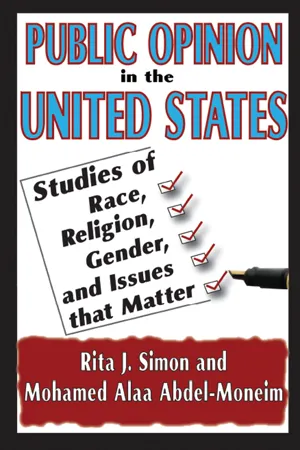
Public Opinion in the United States
Studies of Race, Religion, Gender, and Issues That Matter
- 217 pages
- English
- ePUB (mobile friendly)
- Available on iOS & Android
Public Opinion in the United States
Studies of Race, Religion, Gender, and Issues That Matter
About This Book
Public Opinion in the United States tracks developments in American society since World War II through the lens of public opinion. The authors assess national public opinion poll data from 1945 to 2008, targeting opinions about African Americans, Jews, Muslim Americans, gays and lesbians, immigration, abortion, and affirmative action. The authors consider whether American attitudes have developed faster than Supreme Court decisions in the areas surveyed. They assess how social change is processed by the public, how people responded to the race riots of the 1950s and 1960s, and how the war in Vietnam shaped new perspectives on issues such as race, citizenship rights, and the role of the individual. Each chapter begins by introducing the political, social, or international events that were critical in setting the stage for influencing public opinion in each decade since World War II. The volume provides a unique portrait of American society and how it has changed over the last sixty plus years. The reader will learn whether Americans are more or less prejudiced against blacks, Jews, and Muslims than they were in earlier years; whether their views on immigration, affirmative action, and abortion have changed; and when views have changed, in what direction. Do men and women, rich and poor, more and less educated, secular versus religious share the same views? And if there are differences, what directions do those differences take? Th is work describes American society in 2008 compared to the post-World War II era, and it offers stunning glimpses at the future.
Frequently asked questions
Information
Black Household Income: 1970 to 2006

Black Median Income as a Percentage of the White Median Income from 1976 to 2006
Year | % |
2006 | 61 |
2000 | 65 |
1997 | 62 |
1986 | 56 |
1976 | 58 |
Yes% | No% | Don’t Know% |
42 | 48 | 10 |
Percent Saying Negroes Are as Intelligent As Whites (1942–1963) (NORC)
Year | Percent |
1942 | 41 |
1944 | 42 |
1946 | 52 |
1956 | 77 |
1963 | 76 |
Table of contents
- Cover
- Half Title
- Title Page
- Copyright Page
- Dedication
- Table of Contents
- Introduction: Public Opinion in the United States: A Mirror of Social Contention and Change
- 1 Public Opinion toward African-Americans
- 2 Public Opinion toward Jews
- 3 Public Opinion toward the Muslim-American Community
- 4 Public Opinion toward Gays and Lesbians
- 5 Public Opinion toward Immigrants
- 6 Public Opinion toward Abortion
- 7 Public Opinion toward Affirmative Action
- 8 The United States between 1945 and 1954: A New World Order with Mounting Challenges and Anxieties
- 9 The United States between 1955 and 1964: Institutionalizing Civil Rights and Cold War Interactions
- 10 The United States between 1965 and 1974: A Decade of Opportunities and Strife
- 11 The United States between 1975 and 1984: Setting the Stage for Ending the Cold War
- 12 The United States between 1985 and 1994: Sunset and Dawn
- 13 The United States between 1995 and 2004: Enemy Found but Not Defined
- 14 The United States between 2005 and 2008: A New Social Movement on the Rise
- 15 Concluding Comments
- Index